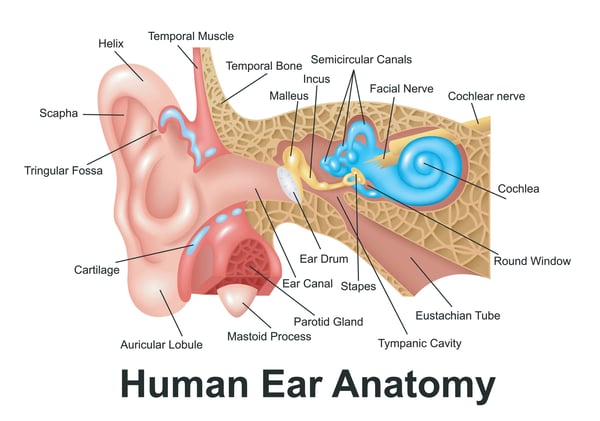Barotrauma is the term used to describe the discomfort or injury caused by increased air pressure during airplane flights (or increased water pressure when scuba diving).
To understand what is happening to cause pain, let’s talk about ear anatomy. 
At the end of the ear canal is the eardrum. Although it is a very thin membrane, it creates an air-tight seal between the outer ear and the middle ear space. Behind the ear drum is the middle ear space. Think of it like a tiny air filled room. The tissues that line this room need air to be healthy (the room also contains the three tiny middle ear bones - the mallues, incus and stapes. This middle ear space is connected to the outside world by a thin tube called the Eustachian tubes, one for the right ear and one for the left. In adults the tube is about the diameter of a pencil lead. These tubes are typically closed, but briefly open to the back of the nasopharynx (nose/mouth area) when we swallow or yawn. This allows air to travel to the middle ear space and equalizes the air pressure with the outside world. When you swallow, you may notice a small “click” or “pop” in your ears. This is a bubble of air being moved through the Eustachian tube. These bubbles constantly move into the middle ear.
Ear barotrauma can occur when these tubes become blocked or partially blocked and air cannot travel to keep the pressure inside the space equal to the outside world.
On an airplane, barotrauma of the ear (sometimes called aero-otitis or barotitis) most commonly happens as the plane descends for landing. The pressure change can create a vacuum or negative pressure in the middle ear space that pulls the eardrum inward. This can cause pain, a stuffy feeling, muffled sound and a sensation that you need to "pop" it. In more severe cases of persistent barotrauma, the middle ear can fill with fluid that is drawn from the tissues that line the middle ear space.
This fluid and/or negative pressure can only be relieved by properly functioning Eustachian tubes or a perforation in the eardrum.
To avoid problems, doctors* suggest
- Begin taking an over the counter decongestant 24 hours before flying
- Chew gum, suck on a lozenge, hard candy, or lollipop….keep swallowing
- Sip liquids
- Try to yawn
- Try not to fly when you have a cold or upper respiratory infection
- Use ¼ percent over the counter Neo-Synephrine nasal spray shortly after boarding the aircraft and again 45 minutes before the aircraft is due to land
- Hold the nose and swallow
- Avoid alcohol consumption while flying - alcohol is a vasodilator and can cause unwanted swelling in the nasopharynx.
- You can also try EarPlanes™, a patented pressure-regulating earplug inserted in the ear to help reduce discomfort associated with air travel. They were developed by Cirrus Healthcare Products LLC in conjunction with the House Ear Institute in Los Angeles, and have been tested by US Navy aviators.
*https://www.mayoclinic.org/diseases-conditions/airplane-ear/diagnosis-treatment/drc-20351707









